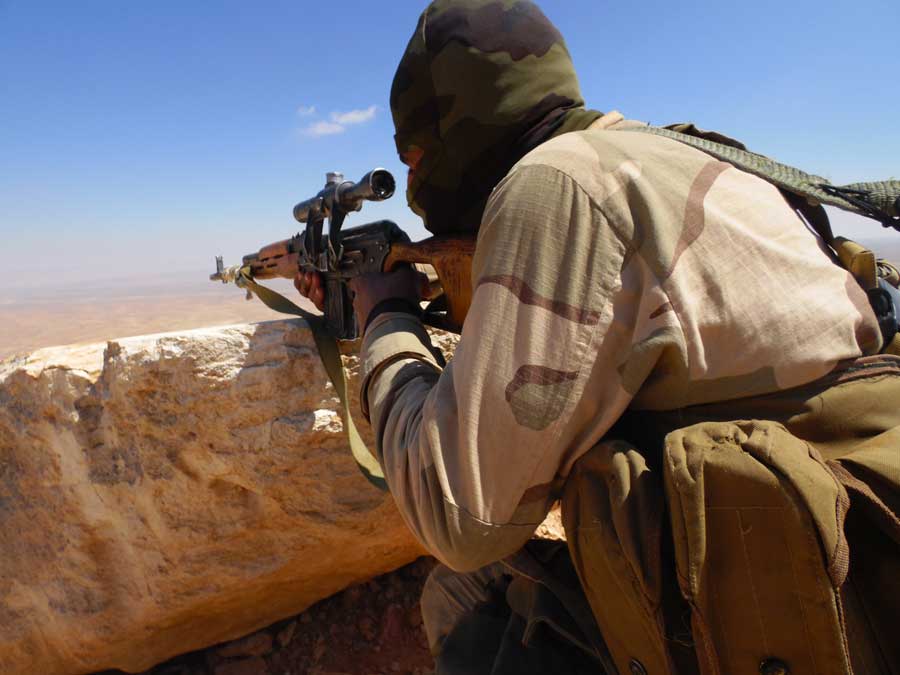- Home
- Articles
- English
The Current Military Map of the Fighters who Originally Come from Deir ez-Zour
Over 2000 fighters are waiting for an army that has to be established
Special Report
The international projects that aim to fight ISIS still disregard Deir ez-Zour province despite its major importance for the organization, which exploits the oil wealth of the province, and they pay no attention to the fact that Deir ez-Zour fighters, especially those who combated ISIS and resisted its invasion in the summer of 2014, are the most able to force ISIS to pull out of the province and the most insistent on achieving that. The battles against ISIS that take place from time to time on the fronts of Aleppo and al-Kalamoun demonstrate great determination of Deir ez-Zour fighters to combat ISIS.
Size, Distribution, and Dispersion
According to estimates by military commanders and informed sources , the number of those who are currently under arms is over 2,200 fighters. Some of them fight within the ranks of large military organizations such as Ahrar al-Sham movement and" Jaysh al-Islam" (the Islam Army), or within independent groups that come from Deir ez-Zour,while others belong to scattered small groups. According to the current data, which suggests that a positive change concerning Deir ez-Zour is going to occur, it doesn't seem that the total number of the fighters is likely to decrease- the fighters suffered a significant drop in number earlier- but it is expected to increase, depending on the circumstances and the transformations of the struggle against ISIS and the regime. The number can double by attracting previous fighters of the Free Army who are living in the north of Syria or Turkey waiting for a serious project to assemble them in a military body ,unified and disciplined.
Combat Objectives and Ideological Orientations
According to lengthy interviews with commanders and fighters that were carried out by those who prepared this report, it was found that the final combat objective for the majority of fighters is to defeat ISIS and the regime, first in Deir ez-Zour,and then in the other Syrian areas, while a minority of them confine themselves to liberating their towns and villages from ISIS. Most commanders affirm their attachment to the revolution project and their adherence to its principles. Such an affirmation can be accepted on account of their former careers within the Free Army groups, and it can be accepted even though it is sometimes made by commanders who have lately joined groups of "salafi" (following the practices and religious traditions of righteous ancestors) and jihadist orientations without their being inspired by ideological motives. On the other hand, one should be cautious with varying degrees – depending on the commander and his life history before and during the revolution- of the revisions that are made by Deir ez-Zour fighters who originally belonged to Ahrar al-Sham or al-Nusra Front before leaving Deir ez-Zour . Yet,if an inclusive and effective military body is created that has a magnetizing effect on them ,so that they can be liberated from their present commitments, such revisions can turn into ideas put into practice, gradually approaching the general national project to a great degree. The readiness of Deir ez-Zour fighters who belong to Ahrar al-Sham movement to join the possible military body differs from the readiness of their counterparts who belong to al-Nusra Front. As soon as such a military body has been created, it is expected that most of Deir ez-Zour fighters who belong to Ahrar al-Sham will leave their organization, while the proportion of those who will leave al-Nusra will be less, and it will vary between the north of the country, where the expected numbers are (50-100)fighters, and the south-Daraa- ,where estimates show that the majority will distance themselves from al-Nusra Front – they are no longer on good terms with al-Nusra and they are organizationally isolated now – and adopt less militant orientations of which the final outcomes are hard to tell, and it is also hard to tell the degree of the constancy of this remoteness and its possible turns .
Flaws in International Training Programmes
The first experiment of training programmes funded by the USA and some regional partners ended in complete failure because it ignored al-Assad's regime as an enemy and concentrated only on "terrorism" as a phenomenon isolated from its general Syrian context. The programmes resumed today appear to be better than the previous ones, considering the growing numbers of recruits and those who are willing to be recruited. These programmes can have higher chances of success if they are put in the context of a wider project, and if two of the preconditions for acceptance are reconsidered :
-The applicant must not have any close relatives who belong to groups of "salafi" and jihadist orientations. Certainly, it is wrongful to condemn someone for something done by another person.
-The applicant must not be a former member of any of the groups that have "salafi" and jihadist orientations, and considering the former membership ofany of these groups a sufficient reason for rejecting, without taking into consideration the duration of this membership and the degree of its originality.
| Geographical dispersion | commander | Number | group |
| North countryside of ar-Raqqa | Mheedi al-Jayla | 300 | Group under formation(its previous name was Force 56) |
| East Qalamoun | Tlass al-Salamah | 200 | Usood al-Sharqi'ya |
| Idlib countryside | Saleem al-Khalid | 200 | Jaysh al-Islam |
| Idlib and Aleppo countryside | Various commanders | 350 | Groups belonging to Ahrar al-Sham |
| Aleppo | _ | 150 | Al-Jabha al-Shami'ya /Security Office |
| In the east south of Badiat al-Sham | Mohan'nad al-tal'laa | 100 | Jaysh Sooria al-Jadeed |
| Aleppo | 50 | Faylaq al-Sham | |
| Aleppo | _ | 50 | Jaysh al-Sham |
| Idlib and Aleppo | Abu Mohammad al-Golani | 300 | Al-Nusra Front In the north |
| Daraa | Abu Mari'ya al-qahtani | 200 | Al-Nusra Front in the south |
| Idlib and Aleppo | _ | 350 | Small groups(10-40) fighters,without names now or specific orientations |
The table has been prepared according to statements of some commanders about the numbers of their fighters, and according to estimates by persons who are acquainted with the groups mentioned above . A distinction has been made between al-Nusra Front in the south of Syria and the general body of the organization, because al-Nusra fighters in the south are out of step with the organization and form a semi- dissenting group .
This report appeared in issue 62, 1 December 2015
Translated by Fayez Masri


 Fayez Masri
Fayez Masri



